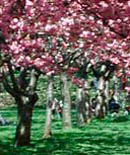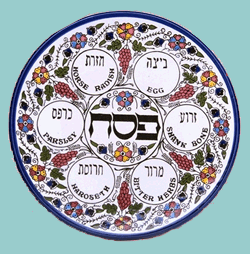
 |
Travels with Laurie: SpringA Home Educator's Travel Guide |
|
|
See also Books That Celebrate Spring / Spring Gardening in NYC / Summer / Fall / Winter
Recommended Road & Field Trips with pre- and post-trip resources (including April Field Trip Ideas) / Tips for Traveling with Kids – making every trip fun for the whole family / Books that Help Us to Appreciate Nature / Armchair Travel
For the Birds!
Then rent a car or get a friend who has one (if you don't) for this fabulous day-trip about 45 minutes from the George Wwashington Bridge. Take I-80 west, to I-278 towards Morristown, to exit 30A, North Maple Ave. Bear left onto South Maple, then turn left onto Lord Stirling Road. Pass an inviting nature center on your left and find the parking area (also on your left) for the Raptor Trust, with an educational center on one side and trails to the birds past the gazebo to your right. This is a bird hospital in the middle of the forest! They are open every day of the year, FREE (suggested donation $2), and have self-guided tours with giveaway information sheets on owls, hawks, eagles, all kinds of raptors. This rescue organization takes injured birds, not just raptors, from all over the state of New Jersey and rehabilitates them to release back into the wild. If we lived closer this is where my kids would be volunteering and interning for hands-on science. But just taking an annual walk through the ramshackle aviaries that dot the shady forest paths and cluster around the hospital building is an unforgettable experience. As you peer through the dim windows and allow your eyes to adjust to the light, suddenly you notice an enormous, dignified Golden Eagle perched above your head, or three tiny saw-whet owls huddled near the corner of the ceiling.
Nearby, Morristown and Basking Ridge offer much history to explore. Signs that "Washington Slept Here" are everywhere. Old inns and taverns offer a variety of menus along with a historical dining experience. A local walking tour (check out the Morristown website) would make another great field trip, along with a visit to Morristown National Historical Park where Washington kept his winter headquarters. |
||||||||||||||||||||||||||||||||||||||||||||||||||
 Garden Gambols
Garden Gambols
The first of May always brings garden blooms to mind, and fond childhood memories of visits to the magnificent cherry blossom esplanade in the Brooklyn Botanic Gardens. Located near the Japanese Garden, the cherry blossom collection boasts over 200 flowering trees, a grouping unmatched outside of Japan. The height of the blooms is usually around May first, and you can check their progress on-line with the CherryWatch Blossom Status Map. Then return in June for the rose garden!
Check out the Bloom Guide for Central Park.
To see what's in bloom this week at the New York Botanical Garden in the Bronx, visit their Gardens & Collections page.
In Yonkers, the Lenoir Preserve, (914) 968-5851, open Wed - Sun, 9 a.m. - 4 p.m., a beautiful 40-acre sanctuary, serves as the headquarters for the Hudson River Audubon Society, which maintains the butterfly and hummingbird garden . The Nature Center, in a turn-of-the-century carriage house, has a five-foot demonstration beehive with glass walls, a 55-gallon terrarium, taxidermic mounts, interactive quiz boards, and more. Educational programs can be reserved for groups. Located on Dudley St., off Broadway (Route 9) about 30 min. north of the city.
Teatown Lake Reservation is a rare wildflower reserve, with 470 acres and a 33-acre lake. Free (donations accepted) Raptor Education Programs are offered on weekends with live hawks, owls, and falcons. Other educational programs also available, call (914) 762-2912 for reservations. Trails are open daily dawn to dusk. Located in Ossining on Spring Valley Road. By car: I-87 North to I-287 East. Stay right for first exit. Turn left onto Rt. 119 East. At next light turn left onto Rt. 9A North. Take 9A to Rt. 134. East on 134 for 0.2 miles to Spring Valley Rd. Turn left and drive about one mile. At the fork, choose left to stay on Spring Valley Road. The Nature Center is just beyond the intersection on the right-hand side, parking just beyond buildings. Teatown is about an hour north of the city, and near the historic homes of Sunnyside, (914) 591-8763, and Philipsburg Manor (914) 631-3992.
Learn about Passover by partaking in family activities and learning about history at the Eldridge Synagogue. You don't have to be Jewish to attend or enjoy these events.
 The Seder Plate |
The Passover Seder plate (ke'ara) is a special plate containing six symbolic foods used during the Passover Seder. Each of the six items arranged on the plate have special significance to the retelling of the story of the Exodus from Egypt. The seventh symbolic item used during the meal — a stack of three matzot — is placed on its own plate on the Seder table. The six items on the Seder plate are:
|